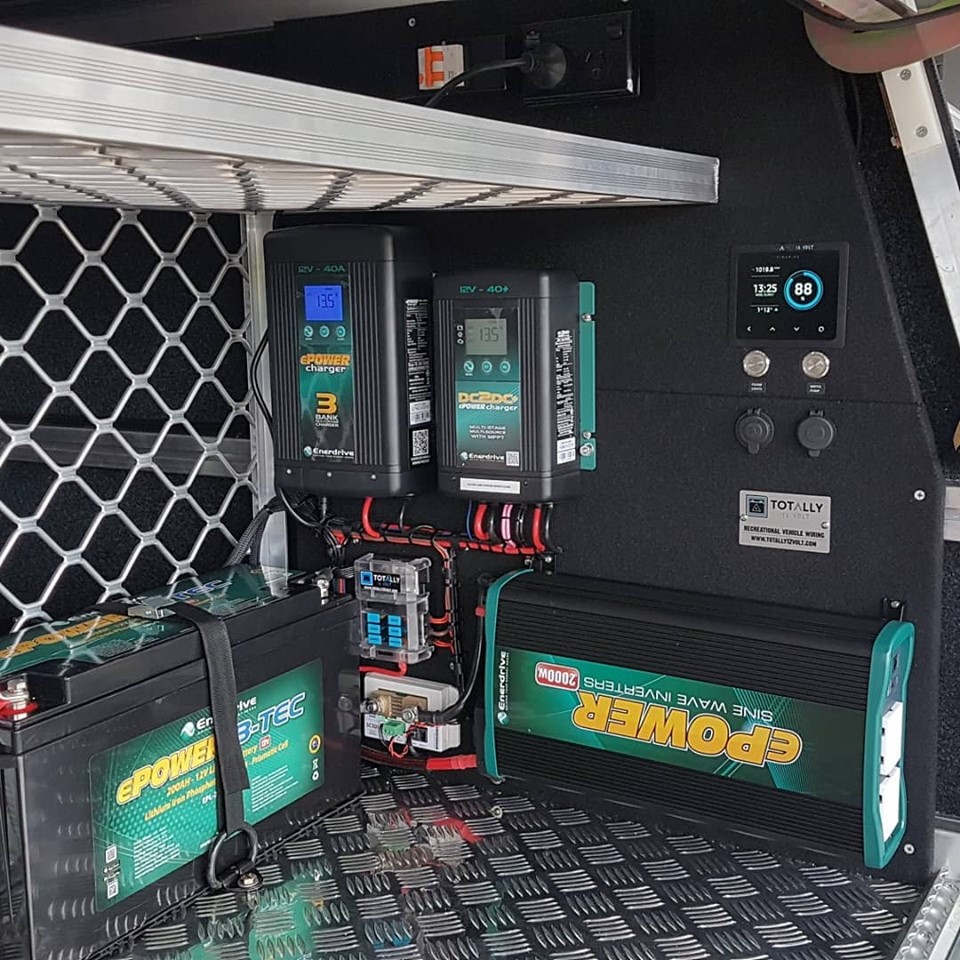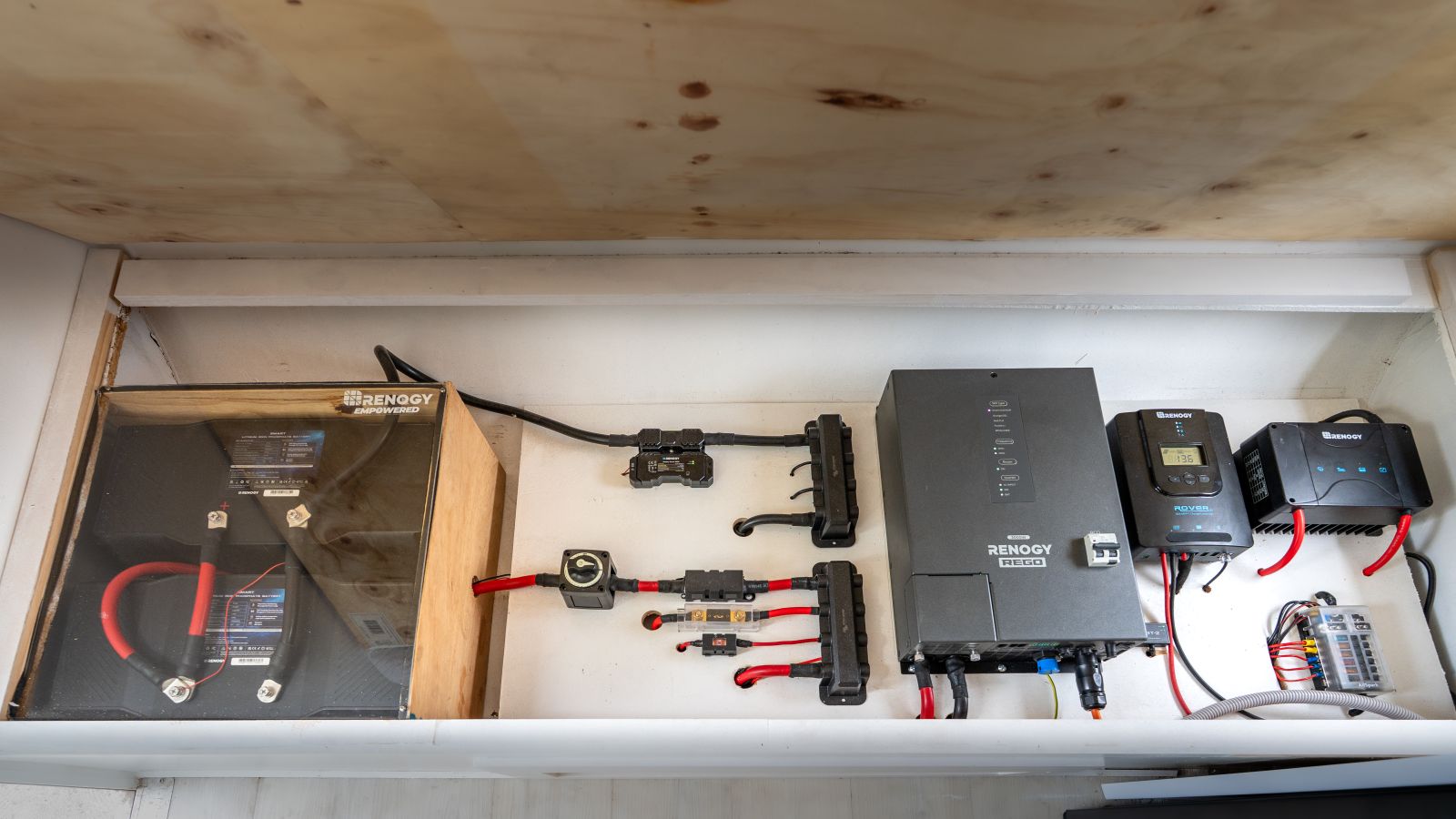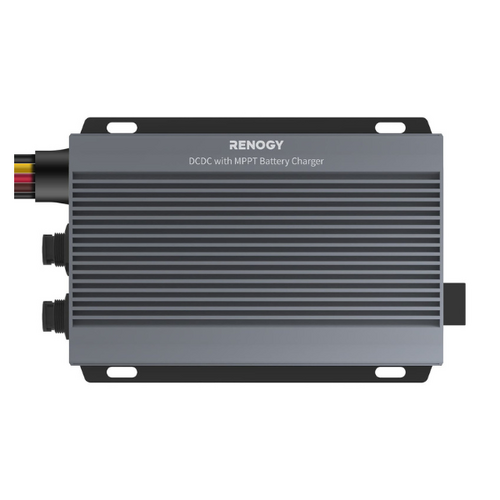Whether you’re travelling for days, weeks, or even months, having a reliable power source is essential to keeping your caravan appliances and electronics running smoothly. That’s where a caravan battery charger comes in. Selecting the right caravan battery charger means you can enjoy power wherever you go, whether you're camping off-grid or staying at a powered site.
Why Reliable Battery Charging Matters
A dependable caravan battery charger ensures that your battery remains fully charged, extending its lifespan and preventing unexpected power failures. Poor charging practices can lead to battery damage, reduced efficiency, and even costly replacements. Whether you're using a DC to DC charger setup for off-grid adventures or an AC smart battery charger for precise charging, having the right system in place makes all the difference.
What This Guide Covers
This comprehensive RV battery charger guide will walk you through everything you need to know, including:
-
The different types of caravan battery chargers and their uses
-
Key features to look for when choosing a battery charger installation caravan
-
The best options for solar charging caravan batteries and off-grid caravan power solutions
-
Expert tips on maintaining and optimising your dual battery charging system
By the end of this guide, you'll have all the information you need to choose the best caravan battery charger for your setup, ensuring you stay powered up no matter where your travels take you.
What Is A Caravan Battery Charger?
A battery charger together with a caravan battery will let you power your caravan and camping electronics and appliances wherever you travel. They work by charging your battery using power from either a generator, mains power, or your starter battery and alternator.
For this to work, you need a dual battery system in your caravan. This means you have one or more auxiliary caravan batteries, in addition to your car battery. Power is stored in the auxiliary battery so you can run electronics and appliances, such as lights, fridge, air-con and more, when the engine or generator is not running. All the while you don’t need to worry about draining the starter battery and getting stranded.
There are different types of chargers depending on how you want to power your electronics.
One uses alternating current or mains power (AC to DC), the other uses direct current from your vehicle (DC to DC):
To think about it simply the flow of energy on the two types of charging looks like this:
-
AC to DC chargers let you charge your battery from a generator or mains power, if you have access. We sell them in 12V, 24V, 36V and 48V options.
-
DC to DC chargers work when your engine is running. It pulls power from your alternator via the starter battery to charge your auxiliary battery. We sell them in 12V, 24V and 36V options.
There are pros and cons to both types.
Generally, an in-vehicle DC to DC charger offers more flexibility on the road. Quality DC to DC battery chargers are designed to sense a wide voltage range and work with any type of alternator or voltage. So, you can make sure you get the correct charging for your specific battery, alternator type, and amp size. As a bonus, some chargers accept other power sources, like solar panels.
Having an AC to DC battery charger onboard as well gives you the option to charge when mains power is available. If travelling offgrid, a small efficient inverter generator can be plugged into the side of the van, which will in turn allow your AC charger to quickly and safely recharge your batteries.
Solar Chargers and Regulators
Solar chargers are an excellent choice for caravanners who spend a lot of time off-grid. These systems use solar panels to generate power, which is then regulated before being stored in the caravan’s battery. A solar regulator, either MPPT (Maximum Power Point Tracking) or PWM (Pulse Width Modulation), ensures that the battery receives a safe and optimal charge.
One of the biggest advantages of solar charging is that it provides a renewable and silent energy source, reducing reliance on generators or powered sites. Solar charging for caravan batteries is particularly beneficial for those who prefer self-sufficient travel and extended stays in remote locations. However, the effectiveness of a solar charging system depends on sunlight availability, making it important to size your panels correctly and invest in an MPPT charger caravan setup for maximum efficiency.
Smart Chargers and Their Advantages
A smart battery charger is designed to automatically adjust the charging voltage and current based on the battery’s condition and type. These chargers use advanced technology to prevent overcharging, overheating, and sulfation, which can significantly extend the lifespan of your caravan battery.
One of the key advantages of a smart charger is its ability to detect different battery chemistries and adjust accordingly. This makes it ideal for various battery types, including AGM battery charging, lithium battery charger caravan setups, and deep cycle batteries. Smart chargers are also highly efficient and can reduce charging times compared to traditional chargers. For caravanners looking for a hassle-free and safe charging solution, a smart battery charger is one of the best options available.
Multi-Stage vs. Single-Stage Charging
Caravan battery chargers can operate using either a multi-stage charging process or a single-stage charging process. The difference between these two methods affects battery longevity, performance, and charging efficiency.
Multi-Stage Charging
Multi-stage charging is a process that delivers power in controlled phases, ensuring the battery is charged safely and efficiently. The key stages include:
-
Bulk Stage – The charger delivers a high current to quickly recharge the battery up to 80% capacity.
-
Absorption Stage – The charger reduces current while maintaining voltage, allowing the battery to absorb the remaining charge gradually.
-
Float Stage – Once fully charged, the charger maintains a low voltage trickle charge to prevent overcharging.
-
Equalisation Stage – This stage is used for lead-acid batteries to balance cells and prevent sulfation.
Multi-stage chargers are ideal for lithium battery charger caravan setups, AGM battery charging, and dual battery charging systems, as they optimise battery performance and lifespan.
Single-stage chargers supply a constant voltage until the battery is fully charged. While this method is simpler and less expensive, it can lead to issues such as overcharging or undercharging, reducing the lifespan of the battery. For modern battery types, especially lithium and AGM, a multi-stage smart charger is a much better choice.
Understanding Caravan Battery Types
Choosing the right battery is just as important as selecting the right caravan battery charger. Different battery types offer varying performance, lifespan, and charging requirements, making it crucial to understand their strengths and limitations.
Deep Cycle vs. Starting Batteries
-
Starting Batteries: Used to start the vehicle engine, they provide short bursts of power but aren’t meant for long-lasting use.
-
Deep Cycle Batteries: Designed for continuous use, these are ideal for powering caravan appliances and electronics. A caravan battery charger should be compatible with deep cycle batteries for optimal performance. Often, a dual battery system includes a starting battery for the tow vehicle and a deep cycle battery for the caravan.
Deep Cycle Batteries (Auxiliary)
AGM Batteries
Absorbent Glass Mat (AGM) batteries are a type of Lead-Acid battery, which are durable and maintenance-free, making them a popular choice for caravans. They're a solid option if you're looking for a robust power source without the higher cost of lithium.
Lithium Batteries
Lithium Iron Phosphate (LiFePO4) batteries are gaining popularity in the caravan world due to their many advantages. They are lighter weight than AGM batteries and can provide power for longer. Here’s a more in depth comparison
AGM Vs Lithium (A quick snapshot):
Battery Capacity & Usable Power
AGM Batteries:
- Best to only discharge to 50–60% of their rated capacity. This conserves lifespan.
- Therefore, a 100Ah AGM battery gives you ~50–60 usable amps.
- Lower continuous discharge, not advisable to power large 240V inverters
Lithium Batteries:
- 80–100% Depth of Discharge. Therefore providing 80 - 100 usable Amps
- More usable power in a smaller, lighter package.
- Hi continuous discharge rating. Ideal for powering 240V inverters and in turn running high powered devices like Air Conditioners and induction cooktops.
Weight & Size
- AGM: Heavier and bulkier.
- A 100Ah AGM battery weighs around 28–30kg.
- Lithium: Much lighter and more compact.
- A 100Ah lithium battery weighs around 11–13kg.
- A 100Ah lithium battery weighs around 11–13kg.
As caravans increase in size, keeping the towing weight as low becomes more important.
Cycle Life (How Long They Last)
AGM:
- Around 300–500 cycles (less if deeply discharged often).
- Typically 3–5 years lifespan.
Lithium:
- Around 2000–5000+ cycles. (depending on depth of discharge)
- Often lasts 10 years or more.
Cost
- AGM: More affordable upfront.
- 100Ah AGM = approx $250–$400 AUD.
- 100Ah AGM = approx $250–$400 AUD.
- Lithium: Higher upfront cost.
- 100Ah lithium = approx $700–$1,500 AUD, depending on brand and features.
But if you factor in usable capacity, weight, and lifespan, lithium often wins over time.
Battery Capacity and Sizing Guidelines
Choosing the right battery size depends on your caravan's power demands. Here’s a general guideline:
Calculate Your Daily Power Usage:
-
Add up the wattage of all appliances (e.g., fridge, lights, TV, water pump).
-
Convert to amp-hours (Ah) based on battery voltage.
Choose a Battery with Enough Capacity:
-
AGM/Gel: Choose a battery with twice your daily power needs, as these shouldn’t be discharged below 50%.
-
Lithium: Can be discharged down to 20%, meaning a smaller capacity may suffice.
Ensure Proper Charging:
-
Use a MPPT charger caravan setup for efficient solar charging.
-
Match your caravan battery charger to the battery type to ensure longevity.
Key Features to Consider
Here are the key factors to consider when selecting a caravan battery charger in Australia for reliable and efficient power management.
Choosing the Correct Size
One of the most crucial aspects of selecting a caravan battery charger is choosing the correct charging amperage. The charger's output must match your battery’s capacity to ensure efficient and safe charging.
As a general rule, a battery charger should provide 10-20% of the battery’s capacity in amp-hours (Ah).
-
Example: If you have a 100Ah deep cycle battery, a 10A to 20A charger is ideal.
-
For larger batteries (e.g., 200Ah or more), a 20A to 40A charger may be needed.
Check the battery specifications. Lithium batteries generally handle higher charger current. Look for the specification called “Maximum Continuous Charge Current”
This number denotes the total charge current the BMS (battery management system) in the battery can handle. Add up all your charging current inputs to ensure the total current is below this number as to not damage the battery.
Example: A Renogy 12V 200Ah Core Series Lithium Battery lists a 100A Maximum Continuous Charge Current. A 50 DC to DC charger and 20A coming in from solar would provide 70A of charge current. Which would recharge this battery extremely quickly and still below the manufacturers threshold.
Temperature Compensation
Temperature variations can significantly impact battery charging efficiency and safety. Some RV battery charger guide models come with built-in temperature compensation, which adjusts the charging voltage based on temperature conditions.
-
In Hot Conditions: Batteries charge faster, but excessive heat can lead to overcharging and reduced lifespan. Temperature compensation lowers the voltage to prevent damage.
-
In Cold Conditions: Batteries charge slower, and undercharging can occur. Temperature compensation increases voltage to ensure a full charge.
If you often travel in extreme temperatures, look for a charger with a temperature sensor or built-in compensation to protect your lithium battery charger or AGM battery charging guide setup.
Protection Features
A high-quality caravan battery charger should include multiple safety features to protect both the charger and the battery. These include:
Overcharge Protection – Prevents excessive voltage from damaging the battery.
Short Circuit Protection – Automatically shuts down the charger if a short circuit occurs.
Reverse Polarity Protection – Prevents damage if the battery is connected incorrectly.
Overheat Protection – Shuts off the charger if it overheats, preventing fire hazards.
These features ensure safe operation, reducing the risk of battery failure and electrical hazards in your caravan.
Display and Monitoring Options
Modern caravan battery chargers often come with LCD displays or LED indicators that provide real-time charging information. These displays can help you monitor:
-
Battery voltage and charge level
-
Charging status and stage (bulk, absorption, float)
-
Temperature readings (if equipped with a temperature sensor)
-
Error notifications (such as overvoltage or short circuit warnings)
For those who prefer a more hands-free approach, some chargers integrate with external battery monitors, allowing you to check power levels without opening compartments or accessing the charger directly.
Bluetooth and Smart Connectivity Features
A smart battery charger with Bluetooth connectivity allows you to monitor and control charging remotely via a smartphone app. Brands like Victron and Enerdrive battery charger models offer these features, making it easier to manage your power system.
Monitor Battery Status – Check charge level, voltage, and temperature from your phone.
Adjust Charging Settings – Fine-tune charging profiles for AGM, lithium, or deep cycle batteries.
Receive Alerts and Notifications – Get alerts for low battery, overcharging, or faults.
For tech-savvy caravanners, a Bluetooth-enabled smart charger can provide greater convenience and efficiency in managing your off-grid caravan power solutions.
Weather Resistance and Durability
Since many caravan battery chargers are exposed to outdoor conditions, durability and weather resistance are important factors.
IP-Rated Waterproofing – An IP65 or higher rating ensures resistance to dust and water, making it ideal for solar charging caravan batteries exposed to the elements.
Heavy Duty Build – Look for chargers with shock-resistant casings to withstand rough travel conditions.
Corrosion Resistance – If travelling in coastal areas, choose a charger with rust-resistant materials.
For off-road and outdoor use, a rugged, weatherproof caravan battery charger will provide long-term reliability, especially when integrated with a DC to DC charger caravan setup.
The Perfect Battery Charger For Your Setup
When selecting the best caravan battery charger, consider your power needs, battery type, and charging environment. Here’s a quick guide to help you decide:
-
For large battery banks or dual batteries: Choose a multi-battery charging model with high amperage.
-
For off-grid and solar setups: Opt for a solar charging caravan batteries system with an MPPT charger.
-
For maximum safety and efficiency: Select a smart battery charger with temperature compensation and protection features.
-
For tech-savvy users: A Bluetooth-enabled charger allows remote monitoring and control.
-
For harsh conditions: A weather-resistant and durable charger will ensure longevity in outdoor environments.
Top Battery Charger Brands
Victron Battery Chargers
Victron Energy is a globally recognised brand known for its premium-quality power solutions. The Victron caravan charger series is one of the most advanced on the market, offering high efficiency and smart connectivity.
Key Features:
-
Bluetooth connectivity for remote monitoring via the VictronConnect app
-
Adaptive multi-stage charging for optimal battery health
-
Supports AGM, lithium, and lead-acid batteries
-
IP65-rated weather resistance, ideal for off-grid and outdoor use
-
Highly efficient with minimal energy loss
Enerdrive Battery Chargers
Enerdrive is an Australian brand known for producing high-quality off-grid caravan power solutions. Their chargers are designed for reliability and efficiency, making them a top choice for serious travellers.
Enerdrive offers all-in-one options to make life even easier, like the Enerdrive 40A DC to DC Charger with installation kit. With the right cable, circuit breaker and cable lugs, it takes all the guesswork out of buying and installing the charger.
Key Features:
-
Multi-stage charging to protect battery life
-
Lithium-compatible chargers with custom profiles
-
High-efficiency charging technology to minimise power loss
-
Robust build quality, designed for harsh Australian conditions
Projecta Battery Chargers
Projecta is a trusted Australian brand that offers a wide range of caravan battery chargers, including smart battery charger models and DC to DC charger caravan solutions.
Key Features:
-
Intelli-Charge technology for fast, efficient charging
-
Supports dual battery charging systems
-
Multi-stage charging for AGM, lithium, and gel batteries
-
Some models include Bluetooth and LCD displays for easy monitoring
BMPRO Battery Chargers
BMPRO is another Australian brand specialising in caravan battery chargers, management systems, and dual battery charging system solutions. Their products are known for their integration with modern caravanning technology.
Key Features:
-
Smart charging technology for multiple battery types
-
Compatible with lithium, AGM, and deep cycle batteries
-
Bluetooth-enabled models for smartphone monitoring
-
Rugged, Australian-designed chargers for off-grid use
Renogy Battery Chargers
Renogy offers reliable and efficient battery chargers for caravans, camper trailers, and RVs. Their chargers support AGM, gel, and lithium batteries, making them a great choice for off-grid and on-road power setups.
Key Features:
-
Lithium Battery Compatibility – Works with lithium batteries for faster and safer charging.
-
MPPT Solar Charging – Maximises solar panel efficiency, perfect for off-grid caravan power.
-
Temperature Compensation – Prevents overcharging or undercharging in hot or cold weather.
-
Built-In Safety Features – Protects against over voltage, short circuits, and reverse polarity.
-
DC to DC Charging – Charges your caravan battery while driving, with some models also supporting solar charging.
-
Value for money - For the packed-in modern features and length of warranty, Renogy presents great value for money in the Australian market.
Which Battery Charger Brand is Best for You?
|
Brand |
Best For |
Key Features |
|
Victron Energy |
High-tech users & off-grid setups |
Bluetooth, multi-stage charging, IP65 waterproofing |
|
Enerdrive |
Off-grid travellers & lithium battery users |
Heavy-duty, high-efficiency, lithium compatibility |
|
Projecta |
General use & affordable smart chargers |
Intelli-Charge, dual battery support, solar integration |
|
BMPRO |
Smart power management & remote monitoring |
Bluetooth-enabled, multi-battery support, Australian-designed |
|
Renogy |
Compact & reliable charging solutions |
Multi-stage charging, space-saving, AGM & lithium support |
Installation Guide
Basic Wiring Requirements
A caravan battery charger needs to be correctly wired to function efficiently and safely. The key components of the wiring setup include:
-
Battery terminals – Ensure the charger’s positive (+) and negative (-) leads are connected correctly to the battery.
-
Fuses or circuit breakers – Install fuses or breakers between the charger and the battery as per the product manuals and electrical standards for your region..
-
Earth grounding – Some chargers require grounding to the chassis for additional protection.
-
Input and output connections – Ensure the AC or DC input power source is correctly wired to prevent malfunctions.
A DC to DC charger caravan setup may require additional wiring considerations, especially if using solar charging caravan batteries alongside a dual battery charging system.
Cable Sizing Guide
The right cable size is crucial for preventing voltage drop and ensuring efficient power transfer. The longer the cable runs, the thicker the cable needs to be.
Use an online cable calculator guide to ensure you can carry the current. But always refer to the manufacturers product manual for a wiring digram.
Here is an example from popular DCDC charger models:
Example: From the Enerdrive 40A DC to DC Charger product manual
When set to 40A output. And a 12V system
Cable length 2 - 5 meters
Starter battery to Charger cable should be 10 - 25mm2
Charger to Deep cycle Auxiliary battery cable should be 16 - 25mm2
Enerdrive 16mm Cable Kit (Inc 70A Fuse) Start Battery to DC to DC Charger (Vehicle Mounted), 5 Metres
Mounting location Considerations
The placement of your caravan battery charger affects performance, safety, and longevity. Consider the following:
-
Ventilation: Avoid enclosed, airtight spaces to prevent overheating.
-
Proximity to the battery: Keep cable runs short to minimise voltage drop.
-
Weather protection: If mounted externally, use IP-rated weather-resistant chargers.
-
Accessibility: Position the charger where you can easily monitor displays, change settings, or troubleshoot if needed.
For permanent installations, secure the charger with vibration-resistant mounts, especially for off-road caravans.
Step-by-Step Installation Process - (General guide only, always refer to local laws, regulations and refer to user manual)
Step 1: Prepare Your Setup
-
Turn off all power sources and disconnect the battery.
-
Gather necessary tools: cables, fuses, screwdrivers, and crimping tools.
-
Check the charger’s specifications to ensure compatibility with your battery type (AGM, lithium, gel, etc.).
Step 2: Choose a Mounting Location
-
Ensure the charger is in a well-ventilated area.
-
If mounting on a wall, use shock-absorbing brackets.
-
Keep the charger away from flammable materials.
Step 3: Connect the Charger to the Battery
-
Attach the positive (+) cable to the battery’s positive terminal.
-
Attach the negative (-) cable to the battery’s negative terminal.
-
Secure all connections tightly.
Step 4: Install Fuses and Circuit Breakers
-
Place a fuse or circuit breaker close to the battery on the positive cable.
-
Select a fuse size based on the product manual recommendations. For example: a 20A fuse for a 15A charger.
Step 5: Connect to Power Source
-
For mains-powered chargers, plug into a 240V AC power outlet.
-
For DC to DC setups, connect to the alternator or solar panel system.
Step 6: Test the System
-
Turn on the charger and ensure it’s working correctly.
-
Monitor the charging process via the display or Bluetooth app if available.
-
Check for sparks, unusual noises, or overheating.
Battery Charger FAQs
What is the difference between a DC to DC charger and a solar charger?
A DC to DC charger is designed to charge your caravan battery from your vehicle’s alternator, while a solar charger uses solar panels to charge the battery using sunlight. Both can be used together for efficient off-grid power solutions.
Can I use a lithium battery with my caravan charger?
Yes, but you need a lithium battery charger that is specifically designed for lithium batteries. Lithium batteries have different charging profiles than AGM or gel batteries, so it’s important to use a charger that is compatible with the battery type.
What is temperature compensation?
Temperature compensation is a feature that adjusts the charging voltage based on the surrounding temperature. This ensures that the battery is charged properly in both hot and cold conditions, preventing damage due to overcharging or undercharging.
Choosing the right caravan battery charger is crucial for ensuring your caravan’s electrical systems stay powered and running smoothly during your travels. Whether you're using a DC to DC charger, a solar charging caravan batteries setup, or a smart battery charger, understanding the different types of chargers, their features, and installation requirements is key to maximising performance and extending the lifespan of your battery.
By considering factors such as battery type, charging amperage, multi-battery capabilities, and safety features, you can select the charger that best suits your needs and enjoy worry-free adventures. Regular maintenance, careful installation, and smart charging practices will ensure your caravan's power system is always ready to support your off-grid lifestyle.
With this comprehensive guide, you now have the knowledge to make an informed decision and set up your charging system with confidence. Ready to find the right battery charger for your needs? Shop our caravan battery chargers here.
-
DISCLAIMER* Please note, this advice is general in nature and we strongly recommend consulting the product manual and where relevant, a professional installer.
Comments (4)
Caravan upgrade.
Hi. I'd like to upgrade my 150w solar panel to 300w and replace the current solar controller from PWM to MPPT so I can use a lithium battery. The caravans original charger could also be upgraded I'm guessing...and possibly the 400w inverter. Could enerdrive offer a nice tidy system for this?By: Wayne Howard on 29 June 2023
www.caravanrvcamping.com.au Response
Hi Wayne, I have reached out to you via email in regards to your enquiry. Please also feel free to jump onto our LIVE Chat or give us a call on 1800 787 278
AC-DC charger
Could you please help me ? I have a CTEK MXS 25 12v/25a charger which has stopped working due mainly to Geckos nesting inside, I need to replace it and am looking at Enerdrive system. I don't need all the bells Etc. as I would.t know how to use it. I also have a stand alone solar system which works well and the battery's do not charge from the tow vehicle. I would appreciate your help and hopefully a sale of your product.By: Mike Rice on 14 May 2023
www.caravanrvcamping.com.au Response
Hi Mike, thank you for reaching out. Our team will contact you via email in regards to an Enerdrive setup!
charging
can i put a separate battery charger on my leisure battery when the caravan is in use i have a 21 swift challenger and the battery charger on it is very slow 2 hours with a generator put 1 volt inBy: DARREN WILLIAM CHARLES MAVIR on 13 May 2023
www.caravanrvcamping.com.au Response
Hi Darren, it sounds like it might be time to upgrade your charger. Give us a call on 1800 787 278 or jump on our Live Chat and we can walk through some options



.jpg)










